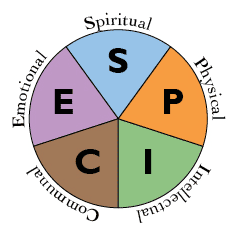For several weeks, I blogged about three new forms of Adaptive Enterprises illustrating the emerging picture of our human evolution in organizing work and workplaces. The first of these and potentially the most commonly experienced is decentralized hierarchy, which primarily focuses on improving efficiency and effectiveness using our heads and hands (beliefs/assumptions and behaviours) to do so.
 As satisfying as improvement is for humans, this does not utilize the full potential of our capabilities. By that I mean we are more than our intellect and behaviour, and we are often highly motivated by those other aspects. Of course I am talking about the heart. At the heart of our beings, we are spiritually, emotionally and communally oriented. I use the acronym SPICE, which includes Spiritual, Physical, Intellectual, Communal and Emotional experiences, as a reminder that whole system change requires whole person engagement (head, hands and heart).
As satisfying as improvement is for humans, this does not utilize the full potential of our capabilities. By that I mean we are more than our intellect and behaviour, and we are often highly motivated by those other aspects. Of course I am talking about the heart. At the heart of our beings, we are spiritually, emotionally and communally oriented. I use the acronym SPICE, which includes Spiritual, Physical, Intellectual, Communal and Emotional experiences, as a reminder that whole system change requires whole person engagement (head, hands and heart).
In the world of socio-technical systems consulting, we traditionally focused our change efforts on core work systems (manufacturing, product or service delivery, etc.) rather than on people thus emphasizing the following belief — there are no bad people only bad systems that frustrate good people from doing good work. In the STS tradition, we recognize people as fundamental in the optimization and innovation of these systems, which is why — through participation and collaboration — we bring community experience into the ‘change room.’ However, we are more than humans doing (head and hands). We are humans ‘being’.
Although our physical, intellectual and communal aspects form our human self, our spiritual being is the essence of who we are and, when engaged, allows us to create new solutions to previously unsolvable ‘wicked’ problems. As our world grows increasingly more complex, so have our problems become more wickedly unsolvable by traditional standards. Hence the need for new ways of organizing beyond centralized and decentralized hierarchies — which typically only engage our heads and hands.
Just as the Web evolved from organizing and sharing information into a second generation of organizing our connectivity and collaboration, so too is the working world evolving into a second generation of Adaptive Enterprises — value creation networks. Rather than organizing around core work systems, these networks form around previously unsolvable wicked problems where all parties can mutually benefit from the value they collectively create. Through the process of collaboration, partial solutions converge into something new and holistic.
A value network’s organizing elements are the key roles necessary for solving the problem, the necessary interactions between these key roles for optimization and innovation, and the deliverables that emerge from these interactions. Interestingly, value networks bypass organization charts, which means they bypass traditional measures of status and authority. And, as we know, creativity cannot thrive where conformity rules.
Free of conformity and external authority, the heart can now inform our collective innovations and visions of possibility. As humans ‘being’, leading in our own lives and deciding on appropriate actions are vital co-creative skills for humanity’s continued evolutionary development. Without balancing head and hands with heart, we will continue to create global financial and ecological crises. By engaging the whole person (beliefs, behaviours and being), we create the shared will and sense-making necessary for resolving these meta social issues.
The evolution from Web 1.0 (The Reading Web) to 2.0 (The Writing Web) to 3.0 (The Transcendent Web*) is paralleled in the three generations of organizing work. Essentially what emerged is a continuum moving us from decentralized organizations to value creation networks to social ecosystems. Although decentralized organizations and value creation networks can be found in a social ecosystem, their value propositions differentiate each from the other.
Adaptive Enterprises and Their Value Propositions
- Decentralized Organizations – Self-Managing Teams striving for efficiency and effectiveness
- Value Creation Networks – Virtual Collaborations striving for effectiveness and mutually beneficial innovation
- Social Ecosystems – Multiple Collaborations striving with shared will for resolution of meta social issues
While social ecosystems form around the shared will to solve a previously unsolvable social issue, mutual gain is not the driver. Instead dialogue processes allowing shared sense-making, shared appreciation, shared purpose and shared consciousness deliver eco-system agreement and local autonomy.
Would you not agree that, by definition alone, a social eco-system engages the heart as well as the head and hands in its resolution/innovation processes? How is your heart engaged in your current work and/or workplace?
*Source: Sabbagh, K., O. Acker, D. Karam, & J. Rahbani. 2011. Designing the Transcendent Web: The Power of Web 3.0, Booz & Company perspective.




